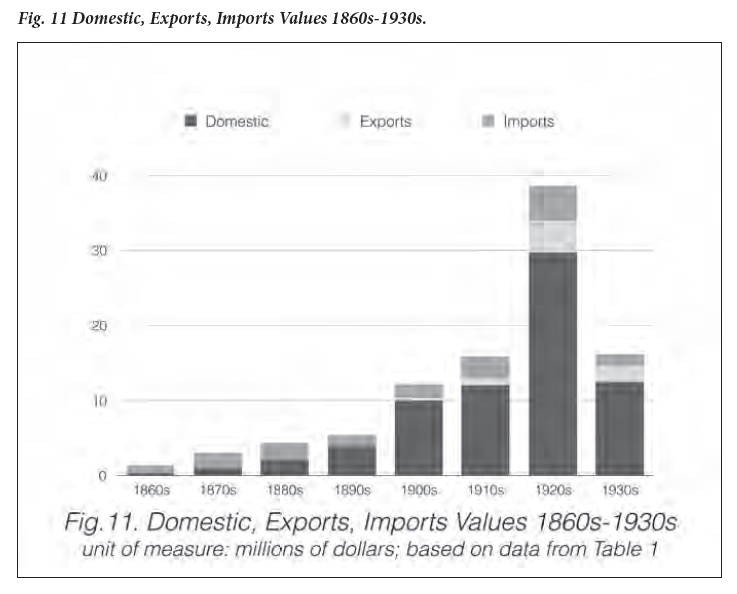Articles
Toward A History of Canadian Wallpaper Use: Mechanization 1860-1935
Abstract
This article examines wallpaper use in Canada from the beginning of cylinder printing in 1860 to 1935. Statistics reveal that the value of wallpaper within Canada grew steadily during this period, before declining precipitously during the 1930s. Canada’s four major factories achieved dominance in their home market by producing low-to-middle grade wallpaper at affordable prices. This paper documents this achievement and explores its significance, centering on a key compilation of primary and secondary sources. From this compilation, costs and patterns of trade are extracted in order to show Canadian development against the backdrop of wallpaper history. Partial comparison to Canada’s chief competitor and trading partner, the United States, is made through analysis of per capita production and consumption figures. This article is grounded in recent scholarship from Europe which suggests that wallpaper can be viewed as an object of use over and above its more familiar role as a minor art-historical artifact.
Résumé
Cet article examine les usages du papier peint au Canada depuis les débuts de l’impression au cylindre en 1860, jusqu’en 1935. D’après les statistiques, la valeur du papier peint au Canada a connu une croissance constante au cours de cette période, avant de décliner rapidement dans les années 1930. Les quatre principales manufactures canadiennes étaient parvenues à dominer le marché intérieur en produisant des papiers peints de qualité inférieure à moyenne à des prix abordables. Cet article documente cette domination et se penche sur sa signification, en se concentrant sur une compilation clé de sources primaires et secondaires. De cette compilation, nous avons extrait les coûts et les circuits commerciaux afin de montrer le développement du Canada sur fond d’histoire du papier peint. Nous effectuons une comparaison partielle avec le principal concurrent et partenaire commercial du Canada, les États-Unis, au moyen d’une analyse de la production par habitant et des chiffres de la consommation. Cet article se fonde sur de récentes études effectuées en Europe de l’Ouest qui suggèrent que le papier peint peut être considéré comme un objet de consommation courante autant, sinon plus, que dans son rôle familier de produit d’un art mineur.
1 Was historic wallpaper consumption in Canada a blank white space? The well-stocked shelves, stylish sample boards, and smiling faces in Fig. 1 belie that impression. Yet, there is good reason for the impression, for the study of Canadian wallpaper has been neglected. The major North American texts about wallpaper, Wallpaper in America (1980) and The Papered Wall (2005, 2nd ed.) lack any discussion of Canada, and yet this neglect cannot be blamed on a lack of documentation. The aims of The Papered Wall—to “provide a current survey of the history of wallpaper in Western Europe and America from its 15th-century origins up to ... the late 20th century”—seem to have fallen short (Hoskins 2005: 7).
2 This article marshals evidence that the Canadian people embraced wallpaper enthusiastically from at least 1860, when mechanization began, until 1930, when record-keeping faltered and production came increasingly under the control of an English monopoly. The problem with the historical record is not that documentary evidence is too sparse, but that wallpaper itself is ephemeral. Wallpaper changed with each generation, and often more suddenly than that; even yearly, as we shall see. The astonishing variety that was offered to Canadian households in a typical year (1911) was recited in the pages of Canadian Bookseller and Stationer:
 Display large image of Figure 1
Display large image of Figure 13 Canada was a latecomer compared with Western Europe, the birthplace of wallpaper from about 1650, or the United States, where domestic production was underway by 1780. Small amounts of hand-blocked wallpaper were being produced in Canada by about 1840 in communities along the St. Lawrence River. Despite this slow start, statistics show an impressive climb such that by 1890 Canadian manufacturers had captured their home market and would soon be exporting as well.
4 The prime research question is this: How did wallpaper use in Canada compare to other nations during mature mechanization? This inevitably provokes more questions: Why does wallpaper matter? What is meant by wallpaper use? One study suggests that nations differed in their contributions to wallpaper heritage:
5 (Hoskins 2005: 7) The use of luxury wallpaper by the upper class in France has been well described by Jacqué (2005/6: 4-7). In contrast, English wallpaper merchants lived up to the “nation of shopkeepers” cliché in their early grasp of the commercial possibilities of wallpaper.
6 How then did Canada compare with other nations? Was Canadian wallpaper use distinctive, and if so, in what way? Particularly, how did wallpaper use in Canada differ from that in the U.S., its chief rival and trading partner? A considerable body of evidence exists to show that the Canadian wallpaper industry did indeed make a distinctive contribution. The qualities of this contribution will be established in this article by answering the questions posed above through a survey of the available resources.
7 One of the limitations of this study is that the eventual combining of the Canadian industry under English control and the cessation of reliable statistics (both occurring in 1927) weaken any conclusions to be drawn about domestic use during the decade of the 1930s. Nevertheless, the importance of Canadian production in the 1920s and 1930s, especially that directed toward the export market, is attested to by other sources.
Definitions and Methods
8 The main entities addressed by this paper are the Canadian manufacturers; specifically, the four largest during the period of 1860-1935. To a lesser extent, distributors and retailers (the trading network) are considered, and, finally, consumers. This de-emphasis on consumers is not because they are thought unimportant. On the contrary, the so-called end user is at the heart of the wallpaper project, and pictorial evidence has been assembled to underline this fact. Wallpaper is an object of delight. It keeps out no rain, steadies no foundation, and protects no surface. Its raison d’être is enjoyment. Without people to experience and share this enjoyment, wallpaper production would be pointless. Yet the inevitable passing away of people and the decorative paper that enriched their homes has left a gap in our historical appreciation. This gap can be partially addressed through careful scrutiny of what remains: a very few wallpapers still in situ, scattered sample books, the written and photographic record, and industry statistics.
9 Each entity mentioned above can be understood through its characteristic literature: manufacturers through their statistical evidence and lines (product offerings); distributors and retailers through their advertisements, promotional booklets, trade magazines, and exhibitions; and consumers through their anecdotes, personal correspondence, and diaries. In particular, the statistical evidence for the Canadian wallpaper industry is plentiful. It therefore shapes this study to a large degree.
10 A key resource for this paper is a report written for Parks Canada in 1983 by Felicity L. Leung. Judging from its ambitious range, Leung’s “Wallpaper In Canada” was inspired by the then newly-published Wallpaper in America by Catherine Lynn. Leung’s report is a vast 900-page compilation of information—sometimes contradictory—scoured from governmental archives and trade and consumer magazines. Though never edited and published, the report has been scanned to a CD-ROM and can be accessed from Parks Canada.
11 The trade testimony catalogued by Leung provides a window into consumer behaviour, although it is important to reiterate Leung’s caution that tradesmen, motivated by self-interest, tend to be less critical toward their wares than contemporary consumers (Leung 1983: 2, 97). Her report contains import/export figures, a rarity in wallpaper research. More important than the report’s limitations or strengths, however, is its orientation: Leung, though grounded in art-historical scholarship, stepped beyond style and toward consideration of wallpaper as material culture. Why this approach was taken is not known; perhaps she was simply ahead of her time.
12 This paper follows Leung’s lead as well as recent scholarly trends. Here, “use” is defined broadly as all stages of the wallpaper project: designing, printing, buying, selling, installing, enjoying, and moving on to the next iteration. All of these human elements are different from—and possibly more significant than—style. The “what” of wallpaper (the formal qualities of its materials, styles, colours, and antecedents) have previously held centre stage. In this paper we will also consider the “why” and the “how” of wallpaper (how it is conceived, made, installed, and displayed in the home or public setting). This emphasis is intended to discourage nostalgia and aesthetic preferences and thus clear a space for the discovery of evidence-based historical trends.
Wallpaper Development
13 Wallpaper was born in Western Europe around 1650 (Kelly 2013). The off-cuts from printing presses were initially block printed with crude designs for the practical purpose of keeping insects and dust out of boxes, trunks, and attics. These decorative papers rose to prominence when they were installed over fireplaces and on adjacent walls. Individual sheets were being joined into rolls in England as early as 1693 (Kelly 2013: 15). The simplicity of the product (little more than cheap water-based inks on cheap paper) made it easy to imitate; it was also extremely versatile, and higher finishes for more discriminating customers were soon available. Sales through stationery stores and upholstery shops followed, and within a remarkably short time (by 1712) the British government was exploiting the popularity of paper-hangings by taxing them. Wallpaper was noticeably popular in England and France by 1750, and made the transition to New France and New England with relative ease, though consumption in the colonies was stunted by the low numbers and uncertain prosperity of settlers (Kelly 2013: 46, 107, 121).
 Display large image of Figure 2
Display large image of Figure 2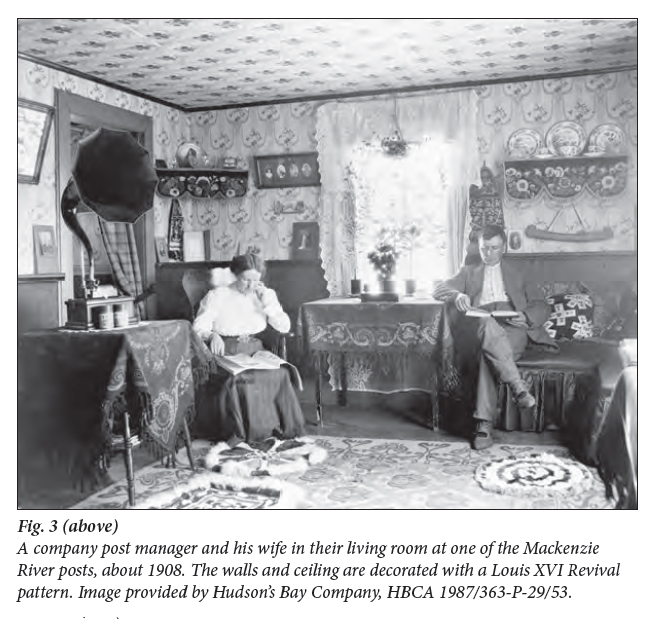 Display large image of Figure 3
Display large image of Figure 314 The first dependable statistics collected by Leung show strong growth in the Canadian market between 1760 and 1790. Amounts coming into Canadian ports climbed from 13,076 rolls during the 1760s to 33,401 rolls in the 1770s, and to 59,473 rolls during the 1790s.1 No doubt this growth from the 1760s was due to the introduction of English rule and many more settlers to Canada at a time when wallpaper was already well-positioned and popular in Britain. During the 19th century, wallpaper became popular in Canada, though it was almost exclusively imported for the first half of the century. Domestic production picked up rapidly after 1850 and, spurred by mechanization, was dominant by 1890.
15 As in Europe and the U.S., there was always a range of products offered at a range of prices. At first it may seem puzzling that wallpaper could be stylish yet still cheap, but this was the genius of wallpaper—varying qualities appealed to varying tastes and pocketbooks. This becomes clearer when we separate style from use. The inspiration for Canadian wallpaper designs may have been European, or even Far Eastern by way of Europe (Figs. 3, 8). Yet wallpaper quickly adapted itself to native housing stock, even when the dwellings were shacks, cabins or huts (Figs. 5, 6).
16 The commissioners of the Great Exhibition in London, 1851, published statistics about the world wallpaper market in 1852. By that time, the U.S. was producing four million rolls, France six million, and England five and a half million per year (Reports by the Juries 1852: 547). When the rolls are equalized (for each country had a different roll size), we learn that the U.S. had moved ahead of France and was second only to England in wallpaper production. On a per capita basis, the U.S. was producing 9 sq ft (.83 sq m) for every six square feet that the French were producing, while the English were producing twelve square feet per person.2
17 More importantly, the statistics compiled in Reports by the Juries confirm that a revolutionary idea had arrived: France had acquired twelve printing machines and England had twenty. However, the U.S. had forty: a sign of the proliferation to come. As if in response, there was a huge leap in consumption in the U.S. around mid-century: the per capita consumption was six times higher in 1860 than it had been in 1850. Consumption continued to rise, from one roll per person in 1860 to around two-and-a-half rolls per person through the Depression, and continuing strong as far as 1950 or so, when it began to sag (see data, Fig. 10).
Historiography
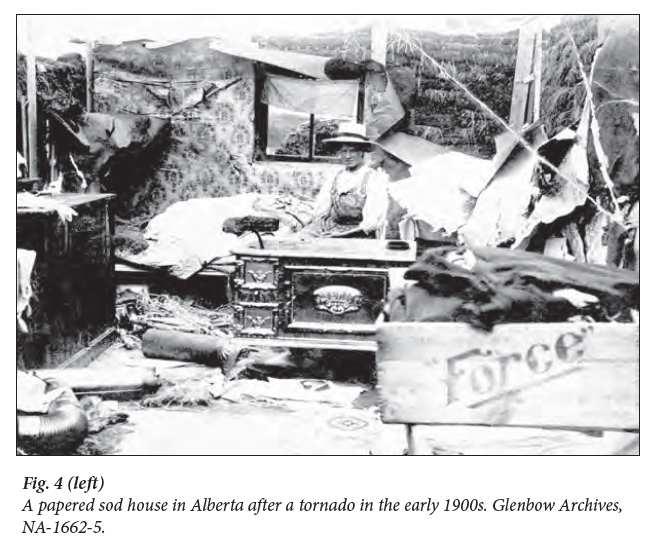 Display large image of Figure 4
Display large image of Figure 4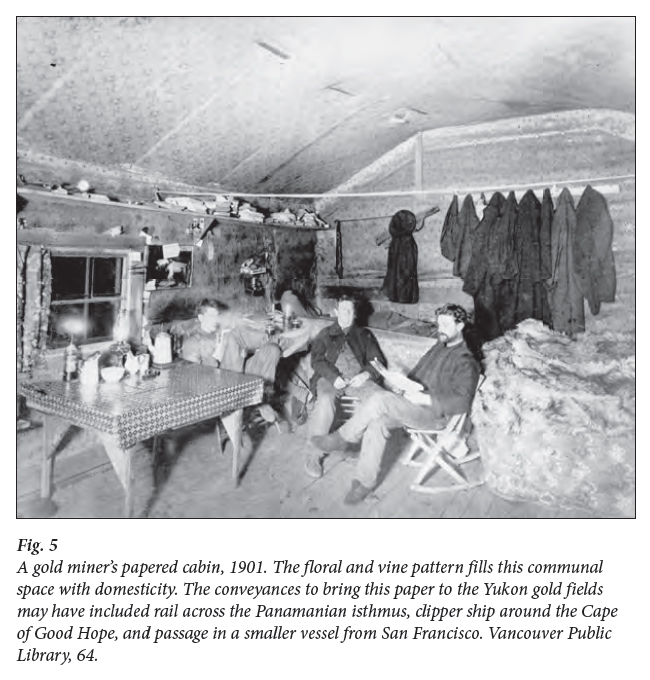 Display large image of Figure 5
Display large image of Figure 518 The American study of wallpaper began in 1908 with Kate Sanborn’s sentimental Old Time Wall Papers. George Leland Hunter’s series of magazine articles, later collected into Decorative
19 Textiles (1918), named wallpaper as a decorative art, albeit a minor one. Nancy McClelland’s scholarly Historic Wall-Papers: From Their Inception to the Introduction of Machinery (1924) also placed wallpaper among the decorative arts. More important than her book’s title may have been the subtitle. Machinery was judged by McClelland as a degradation from block printing. Henri Clouzot’s introduction was even more disparaging toward production by machine:
20 This assertion of a sort of technological determinism in reverse carried weight because of Clouzot’s expertise in French decorative arts, primarily textiles.
21 It was not appreciated at that time that block printing had arguably produced just as much inferior wallpaper as machines, and that machinery was far from a one-dimensional stamping apparatus. Thus, even as academic study began, common wallpapers—the decoration of the middling, working, rural, and immigrant classes—were already being marginalized by the academy. That these types continued to proliferate (peaking in per capita consumption of 2.7 rolls per person in the U.S. around 1947) must have only seemed to confirm the judgement.
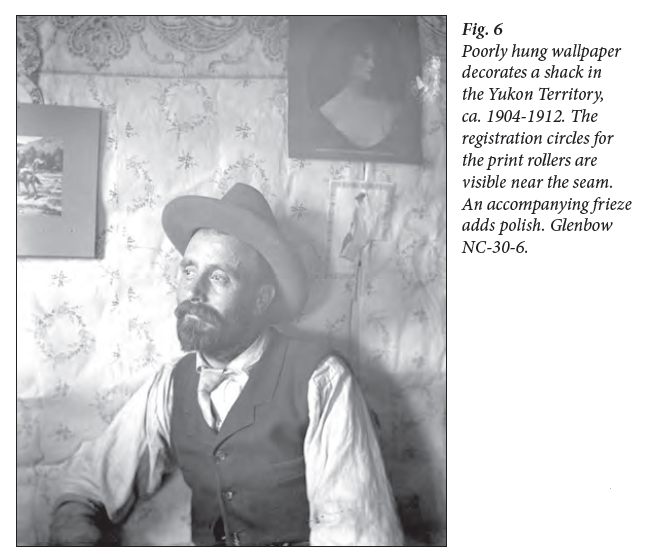 Display large image of Figure 6
Display large image of Figure 622 The next phase of wallpaper historiography might be called nationalistic: large monographs were devoted to single countries: again, McClelland in the U.S. (1924), Sugden and Edmundson in England (1926, A History of English Wallpaper 1509-1914), and Clouzot and Follot in France (1935, The History of Wallpaper in France). Some of these texts claimed originality and even the “invention” of wallpaper, as if it were a trade secret (Sugden and Edmundson 1926: 9). Such claims seem quaint now that the indigenous development of wallpaper in many nations has been explored (Broström and Stavenow-Hidemark 2004; Heijbroek and Greven 1994; Stavenow-Hidemark 2007; Thümmler 1998; Skinner 2014).
23 Wallpaper study changed radically in 1980 with Catherine Lynn’s Wallpaper in America, which took a comprehensive and historical approach. Nevertheless, the tradition of representing wallpaper as style was so strong that her book included abundant examples of European wallpaper in America long past the time that American wallpaper had achieved commercial dominance.
24 Two ground-breaking texts about the material culture of wallpaper are Anthony Wells-Cole’s Historic Paper Hangings (1983) and Bernard Jacqué’s Technique Et Papier Peint (1991). Christine Woods has written about the influence of design hierarchies and national bias on British wallpaper literature (1999). She has also stressed the importance of mass-produced, late-19th-century “sanitary” wallcoverings (Woods 2007). Christine Velut’s contribution may be the most unexpected of all: her article suggests an entirely new direction for wallpaper study by positing “design” not as a thing, but as a negotiation between producer and consumer. She gives great weight to price and quality as well as design, and writes that “the apprenticeship of manufacturers in the area of aesthetics was served ‘on the job,’ by paying constant attention both to developments in neighbouring domains and among competitors” (Velut 2004: 67).
25 Michael Lech, curator at the Historic Houses Trust of New South Wales, Australia, explains the collecting policy of the HHT: “in effect, there is no preconceived notion in the collection policy that certain styles or types are more desirable than others” (Lech 2011/12: 62). This policy, which deemphasizes the taste of both original consumers and later-day commentators, allows and even celebrates glimpses into the domestic lives of early Australian settlers, who hung layer after layer of wallpaper on their timber slab huts. We pause to wonder if this activity is any different than that of the early settlers of Manitoba or Alberta, who also hung cheap wallpaper, layer after layer, on their cabin walls (Figs. 2, 3, 4, 5, and 6).
Canadian Development: Climate and Continuity
26 The transmission of wallpaper from Old France to New France shows continuity. In one instance, a Western European adaptation of a Chinese design was hung in a Québec townhouse with French upholstery methods (Hamel 2008). Elite wallcoverings were hung at Government House (formerly La Masion des Indes) in Montralé in the late 1770s, and a job tacking up a canvas frame followed by “inge” (Indian, or Chinese) wallpaper was billed to the “Shato” (Chateau St. Louis) in Québec in 1781 (Leung 1983: 56, 62).
27 Canadian military regulations of the early 19th century, found at Library and Archives Canada, often mention wallpaper and tend to corroborate what insubstantial civilian records cannot: that by 1805 wallpaper was on its way to becoming a “customary” component of Canadian interiors, in the words of a royal engineer in Halifax writing to his inspector general (qtd. in Leung 1983: 75).
 Display large image of Figure 7
Display large image of Figure 7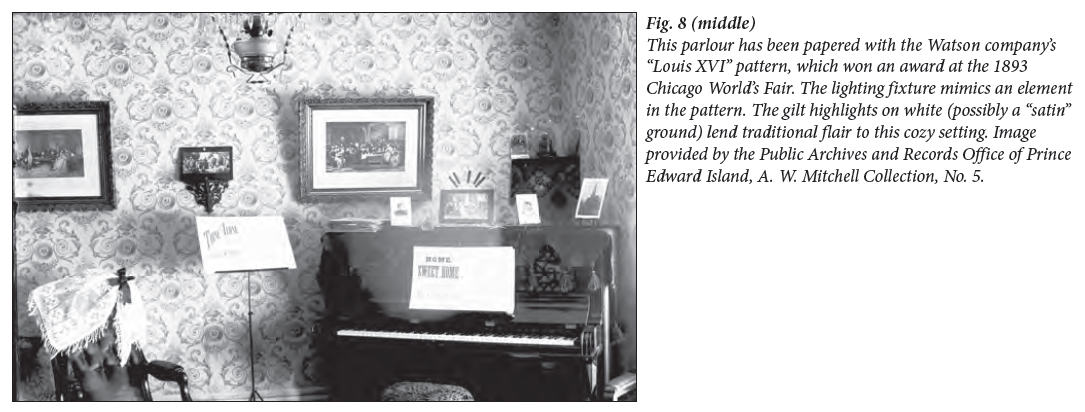 Display large image of Figure 8
Display large image of Figure 8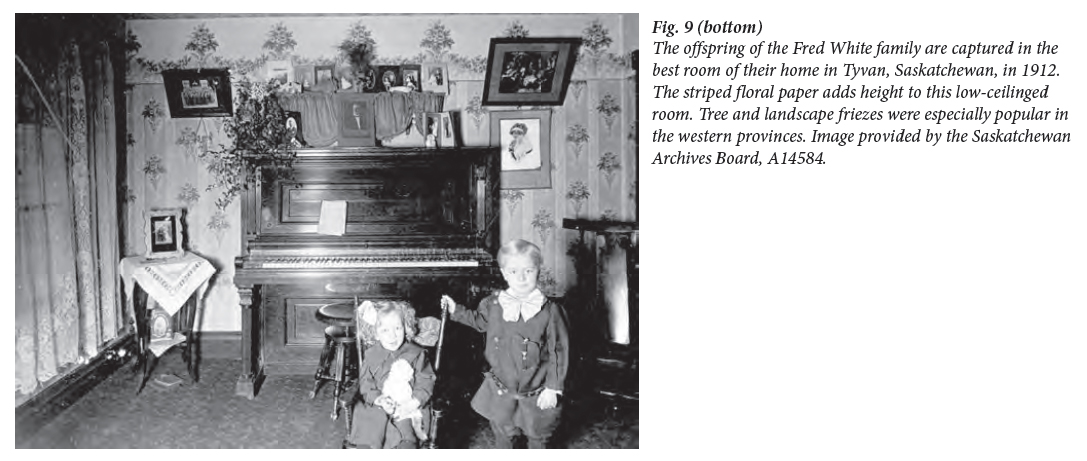 Display large image of Figure 9
Display large image of Figure 928 In 1818, a request of Captain Faddy of the Royal Artillery to his superior officers sheds light on another reason why wallpaper became so popular:
29 This is the first direct reference to the insulating qualities of wallpaper, but indirect references abound. As many as eighteen layers of wallpaper were found in lighthouses dating from the mid-19th century at Bonavista and Cape Spear (Leung 1983: 133). No doubt these extra layers of insulation were welcome since they buffered the howling winds of the North Atlantic. Despite the insulating qualities of several layers, a significant shortcoming of wallpaper was that a single layer hung directly on wood would split under the stress of seasonal contraction; it was soon found that a layer of fabric tacked up prior to papering would help secure and preserve the installation. This scrim underlayment had many names. It was usually called “paperhanger’s canvas” in the U.S. and “hessian” in Australia (Kelly 2012).
30 Hints of this practice can be glimpsed in Fig. 6: the paper looks almost quilted, so loosely does it drape the walls. Figure 4 shows the unhappy results of a tornado tangling with a wallpaper/ frieze combination in a sod house. Naturalistic floral patterns like these were still popular as late as 1900 despite design trends toward simplicity and abstraction. Large furnaces like that shown in Fig. 2 were popular, yet they too caused expansion and contraction of the wallpaper on plank walls. Sometimes this caused the corners of the wallpaper to pull away from the wall. Many rural Canadian interiors featured wallpaper on the ceiling as well (Figs. 3 and 5). Perhaps a snug, nest-like interior was the object. One interesting practice beyond the scope of this paper was papering the walls with pages from periodicals and newspapers. Photographic evidence in the Parks Canada archive for this ad hoc practice in Canada reveals that it was not dissimilar to documented installations in the Appalachian mountains of the U.S. (Public Archives Canada: C 5393; Martin 1983).
31 The importance of emigrant craftsmen for the wallpaper industry is underlined by the fact that the heads of all 19th-century Canadian manufacturing companies were from Ireland or Scotland (but curiously, not from England, the mid-century centre of the paper-staining industry). Three of these emigrants founded long-running businesses. Their name is given with the duration of their companies: Moses Staunton (Irish), 1856-1927; John C. Watson (Scottish), 1879-1927; and Colin McArthur (Scottish), 1879-1927. The fourth large factory was started in 1908 by Reginald N. Boxer, a native-born Canadian, and directed by him until 1927. Several companies were of shorter duration: McDonald and Logans (1842-1844), the Barber Brothers, operating the Georgetown Wall Paper Factory (1861-1883), and the Menzie Wallpaper Company (1903-1908). Angus McDonald and the Logan brothers were from Scotland, and the Barber brothers were from Ireland. In all, there were twelve known companies, but the vast majority of wallpaper in the period was produced by four entrepreneurs: Staunton, Watson, McArthur, and Boxer (Leung 1983: 295).
32 Canadian wallpaper came into its own during a specific milieu. The short-lived wallpaper factory of McDonald and Logans began in Portneuf on the St. Lawrence River in 1842, but was gone by 1844 (Leung 1983: 311-12). This first mill was not significant, perhaps due to an incipient lowering of the tariff on foreign goods (in 1843) that the owners could not have foreseen. Nevertheless, the mid-19th century in Canada was generally a time of exploration and expansion, driven by significant changes to transportation, mechanization, and population.
33 Meanwhile, by 1850 the European and U.S. wallpaper industries had witnessed two innovations: “endless” paper in 1830, which replaced the laborious method of pasting single sheets together to make up a roll (Lynn 1981: 59); and cylinder printing, which replaced hand-block printing, though this change was by no means abrupt. Block printing continued, in some measure, in large mills until at least 1880 (Leung 1983: 185; Jacqué 2005: 178).
The Trading Network
34 Pioneers in the early 19th century forged north and west across the continent, bringing wallpaper with them as they settled the land. These settlements in turn generated ever-larger networks of demand and supply. Railways were laid in the mid-19th century, spurring more growth. The initiative shifted from maritime, rivers, and Great Lakes ports and toward burgeoning inland cities in Ontario.
35 At the leading edge of the distribution chain were individual tradesmen. Montréal ads in the 1820s reveal that paperhangers, upholsterers, auctioneers, cabinet makers, painters, druggists, stationers, conveyancers, and fancy trade dealers, including a parasol maker, were avid purveyors of wallpaper. For example, Charles Cummings sold linens, leathers, and wallpaper (Advertisement 1823). A few years later, D. McAfee, a paperhanger, painter, and glazier, claimed “strict adherence to the most improved modes of finishing rooms, halls, staircases” (Advertisement 1825). Salesmen (commercial travellers) like Colin McArthur came next. McArthur created demand and filled orders for his employer, Wiley and Lochhead, a prominent paper-staining company of Edinburgh (Kinchin 1991: 16). Josiah F. Bumstead, an American manufacturer, recorded in his journal on September 27, 1852, that he was sending salesmen on annual trips to the western territories and Canada (Bumstead 1852, vol. 7: 641).
36 At the Port of Toronto in 1843, the wholesale price of imported American paper was recorded at 9 to 25 cents per roll (Leung 1983: 115). The lowest-priced wallpapers were described as “common hanging papers,” presumably with only one or two design colours. However, when wallpaper was sold in the western territories, prices often jumped to 50 or 75 cents per roll, suggesting that scarcity justified a mark-up. Similar retail prices were recorded in Victoria (Leung 1983: 148) and in the Oregon territory.3
37 The roles of the painters, paperhangers, and gilders of the 1820s and 1830s were taken up by partnerships and storefronts in the 1840s and 1850s. None of these could have succeeded, however, without the attention of the salesmen who continued to help local retailers to know what was available and manufacturers to know how much to produce. Well-stocked wallpaper stores proved popular in cities but less so in small towns, where demand was lower. The solutions—mail order and regional wallpaper factories—were yet a long way off. Wallpaper was making inroads, but the country was vast. As late as 1837, Anne Langton, a British resident settling in the bush area near Fenelon Falls, Ontario, commented that “a papered room, save in the government house, I have not seen since we entered the province” (qtd. in Leung 1983: 98).
38 The merchandising evolution in the east, from individuals to small stores of the 1820s through 1850s, repeated itself in the settling of the western provinces. Many must have followed the path of I. N. Jeffries of Victoria, a house, steamboat, sign, and ornamental painter and grainer. He added to his duties by selling “wall-papers and borders of the most recent pattern” (Advertisement 1860). In 1863, F. Stemmler and Co., “practical upholsterers and paper hangers,” of Victoria, were “prepared to execute all kinds of work pertaining to the business” (Advertisement 1863). Sofas and lounges were made or repaired; carpets were sewn and laid; window curtains and cornices were fixed; and papers were hung.
39 It was by no means a straightforward process, but eventually the personal attention of the commercial travellers was displaced by two other selling methods, both originating with the manufacturers—sample books and postcards. With these tools retailers could order room-lots of wallpaper. Many small retailers ceased stocking, thereby saving space and capital. Finally, mail order catalogues arrived, allowing direct sales to consumers (Leung 1983: 347). Eaton’s department store of Toronto built a mail-order empire on this principal. In fact, a large wallpaper factory was erected in Toronto to produce goods destinedlargely for Eaton’s mail-order customers (230). Figure 4 shows wallpaper patterns and a matching frieze typical of many in the contemporaneous Eaton’s catalogues.
40 Styles in Canada were remarkably similar to those in other Western nations. However, it may be significant that in no other country, in the research experience of this writer, was “cheapness” so openly acknowledged as the prime selling point. Usually, a combination of qualities were touted. In the U.S., for example, “elegant and cheap Paper Hangings” were advertised by John and George Hagerty (Advertisement 1793). And, Josiah Bumstead announced on his billhead: “Special pains taken with all the Low Price Papers ... Good-looking and Tasty as well as cheap” (Billhead 1853).
41 Much attention has been focused in wallpaper historiography on wallpaper with distinctive physical qualities. One such type, embossed and varnished Japanese leather paper, has been studied in the pages of Material Culture Review/ Revue de la culture matérielle by none other than Felicity Leung (Leung 1988). Yet Leung also states flatly that “the largest proportion of Canadian production was of lower grades” (Leung 1983: 185). Little description was offered in advertisements, perhaps because it was not thought necessary. Nor did Canadian wallpaper have a distinctive style. To be sure, Canadian motifs were found on wallpaper; Leung mentions that in the 1930s “maple leaves, skiers, Mounted Policemen, Canada geese, birch trees, and caleches in Quebec” all made an appearance (262). But these were novelty papers. Almost any surface design motif might have been used for wallpaper, so vast was the output, which was measured in the millions.
42 The story of Canadian wallpaper is therefore not one of style, but one of adaptation, copying, and dispersion. But this is no reflection on native talent because from earliest times appropriation of style was the basis of the wallpaper trade (Lynn 1980: 70; Nylander, Redmond, and Sander 1986: 116, 122). It is not so much what was interpreted (Louis XV, japonaiserie, florals, damasks, or stripes) as how this was done (with blank, common, or satin wallpapers).
43 Blanks featured one or two design colours printed on raw paper which had been dyed in the pulp. Common papers had one background colour brushed on prior to the printing of designs. This “staining” of the background gave rise to the traditional term for wallpaper manufacturing: paperstaining. The additional step of polishing the surface resulted in a glazed or satin finish, one that enhanced dimly lit interiors. Flocks and embossed papers were found in elite interiors. More prevalent and even common by the 1880s were gilts, also known as “bronzes.” The metallic powders of these inexpensive to moderately-priced patterns glimmered in the gas-lit interiors of late-Victorian parlours. The ingenuity of the manufacturers was seemingly directed at the expression of style. Yet their greatest achievement may have been economic—that they provided style at an acceptable cost for consumers while eking out a profit for themselves.
Moses Staunton: “...no getting on without hard work here...”
44 The career of Moses Staunton illustrates what emigrant craftsmen faced and how they coped. Staunton offered great varieties of wallpaper from his workshop (Belfast Street Directory 1843). When the Irish industry hit the doldrums, Staunton, like many of his fellow craftsmen, went to Liverpool, England. His advertisements in Belfast and two patented wallpaper designs in England (Staunton 1845) establish that he was a seasoned professional well before his removal to Canada.
45 The Staunton family’s arrival off Cape Race, NL, in September of 1854 was abrupt. His brother in Liverpool, R. J. Staunton, passed along to other family members the news that their ship was wrecked on island rocks: “They reversed the engines and got off the rocks into deep water and found that the vessel was greatly damaged so they ran her ashore on the beach during which time all Moses’s family were expecting to be lost every moment” (Staunton 1854). Moses Staunton helped build bonfires and tents, and the stranded passengers roughed it for several days. Earning a living was no less demanding. He wrote dutifully to his mother on Christmas Day, 1856:
46 In that same year Staunton established his factory in Toronto, promising the public that he would print wallpaper “suitable for decorating dining rooms, drawing rooms, parlours, bed rooms, halls, offices.... Borders in every variety” (Advertisement 1856). The ad went on to list “... Velvet, Gold, Satin, Oak, and Plain papers.” It’s likely that his pioneering workshop specialized in the plain varieties. Not only were they cheaper to make, but suitable grades of paper could be milled nearby. The rudimentary patterns of simple block prints were easily adapted to local custom, unlike highly evolved speciality goods from abroad, which played a different role: to spread style.
47 As the 1860s began, Staunton’s factory was equipped with a hand-powered two-colour cylinder printing machine. Proving the international character of the industry, he added a four-colour machine from Thomas Gadd (England) in 1861 and a six-colour machine from John Waldron (New Jersey) in 1863 (Leung 1983: 298). After a provincial exhibition in Kingston, ON, in 1867, a newspaper described Staunton’s work as being a “very pretty design and a good durable paper,” giving some insight into local criteria (Review of Exhibition 1867). By 1871 he was processing 200 tonnes of paper stock annually (Census 1871). In 1873 Staunton began trading with Colin McArthur, the salesman we encountered earlier. These two became the founding fathers of Canadian wallpaper.
The Fruits of Mechanization
48 Paper consumption grew in Canada throughout the 19th century, reflecting growing prosperity but depleting the supply of rags, the raw material for paper stock. In 1854, The Canadian Journal speculated about novel sources of raw material: straw (wheat, barley, oats or rye), turf, cowdung, manila, hemp, cudweed, thistle, and white woods.4 At a Toronto exhibition in 1858, a rag-and-straw paper made by the Don Valley mills of John Taylor was used for a prize-winning wallpaper from the Staunton workshop (Leung 1983: 359). The shortages of raw material for papermaking were solved by adopting a method that seemed tailor-made for the North American region: the mechanical pulping of trees. By 1890, “straw and wood ... replaced linen and cotton rags as sources of cellulose” for wallpaper stock in the U.S. and Canada (Clapp 1981: 67; Leung 1983: 358).
49 With mechanization came complications: small companies lacking a specialization found it hard to compete. After ten years of paper-staining, the Georgetown Factory was forced to downgrade. They survived as a window-shade factory from about 1870 to 1883 (Leung 1983: 330). These shades, also known as curtain paper, were a low-grade product popular on the frontier. Despite the name, they did not hang down either side of a window but were centered on the window itself.
50 The Staunton factory won awards for their ungrounded papers (Leung 1983: 314). However, a polished ground seems to have set the standard in the U.S. from an early date. None of the prizewinning wallpapers at exhibitions of the “Useful Arts” in Boston, New York, Philadelphia, and Baltimore between 1820 and 1860 have been described as ungrounded papers in the available documentation. More evidence that inexpensive wallpapers were important came in 1887 during a Canadian House of Commons debate, when Sir Charles Tupper, the minister of finance, stated that:
51 Tupper was defending Canadian producers from charges that home tariffs “limited the availability of cheap wallpaper demanded by poorer Canadians” (302). The National Policy of the Macdonald government in the late 19th century was generally favourable toward domestic products such as wallpaper. Despite being composed of local wood pulp, wallpaper was regarded as a “non-indigenous” product by national policy-makers (Leung 1983: 293). This designation allowed for economical importation of special pigments and other chemicals.
52 Mechanization was a boon for the middle class and the masses. It resulted in lower prices, which boosted consumption. An odd effect of price competition was that cheap copies of flat ornament design, a pet project of English reformers like Owen Jones (1809-1874), became popular enough to compete with designs based on naturalistic flowers and the crockets and pinnacles of Gothic cathedrals, which had so offended the reformers’ sensibilities.
53 Yet despite the growing popularity of cheap wallpaper, specialities from the most celebrated companies of Europe continued to be installed in high-profile buildings, just as they had been in the 1780s. One installation took place at Government House in Westminster in 1864. In that same year the Victoria Government House was furnished in high style by the J. G. Crace firm, which enjoyed the patronage of the queen herself. Crace supplied paper-hangings at seven shillings per roll. Since a shilling was worth about twenty cents, each roll of twelve linear yards was worth $1.40—far more costly than most wallpaper of the era (Leung 1983: 129, 150).
The Limits of Mechanization
54 George Eulas Foster, minister of finance, responded in 1894 during parliamentary debate, with some heat, to Sir Richard Cartwright’s assertion that imported paper connoted superior taste:
55 Though Foster’s sincerity cannot be doubted, it’s impossible to confirm the “thoroughly Canadian sentiment” that he ascribed to those wallpapers. English design reformers such as Owen Jones had recommended national symbols for wallpaper motifs, but there is no evidence that such didactic patterns came into general use in any country. By 1894, wallpaper styles had long since shed direct evidence of national origins; already by 1815 or so French, English, and U.S. wallpapers were so similar in style and finish that they were difficult to tell apart (Hoskins 2005: 126). A running theme in the journal entries of Josiah Bumstead is the desire of American craftsmen to dissolve the differences between domestic wallpaper and foreign models: “you cannot tell the difference between the two,” he wrote approvingly on September 18, 1841 (Bumstead 1841, vol. 1: 101).
56 Wallpaper styles had a habit of coming back. Louis XV and XVI Revival styles were popular worldwide in the 1870s, much to the disgust of English reformers, and came back again in the 1890s, again much to the disgust of English reformers. Yet Canadian “Tables of Trade and Navigation” (Parliament 1870-1901) show that only tiny amounts of genuine French paper-hangings were imported during the 1870s, and still fewer in the 1890s—confirming that significant imports from Europe had all but ceased.6 What looked like French wallpaper was actually being produced by the U.S., the U.K.,and even Canada. Indeed, Leung reports that the Canada Wall Paper Factory bought designs for production in the late 1880s directly from Paris, London, and the U.S. (Leung 1983: 192). Buoyed by proliferation, technology spawned a flow of new products and terminology. More than fifty grades of paper were needed for types of wallpaper by 1933 (356).
57 Whereas cabins, huts, and shacks had been likely candidates for wallpaper in the rough years, increasing affluence in Canada encouraged a broader use of the product. The fashion for wallpapering commercial structures became widespread in the late 19th century and hung on for many years. A jewellery store in Cobourg, ON, was papered nicely, as might be expected, but drugstores and saloons also got wallpaper. More surprisingly, wallpaper finery came to a poultry showroom in Regina and an auto service station in Vancouver.6 A minor exception to European-inspired novelties, standbys, or revivals was the “Indian” style briefly popular during the First World War (Leung 1983: 768).
58 After 1900, the fashion-forward wallpaper styles—art moderne, cubism, futurism, and above all “modern English” (art nouveau)—continued to emanate from Europe. Art nouveau papers decorated schoolhouses in Saskatchewan circa
59 1910 and the library of a governor’s residence in 1914.7 These were not the art nouveau patterns of Paris or New York City café society. Instead, they were adaptations to fill consumers’ need for flat pattern and modular ornament. Canadian manufacturers played an important role as gatekeepers by reinterpreting outré styles for the mass market.
60 The art moderne style shown in a Canadian Wallpaper Manufacturers Limited (CWM) advertisement in September of 1929 was labelled as “Modernistic.” The ad featured sprawling diagonal flame-like designs on a dark ground punctuated by small orbs, behind bedsteads in characteristically semi-circular forms. Another issue of the magazine featured an ad for a cubist-inspired design employing what looks like a collection of children’s building blocks to “meet the vogue for rich, bright surroundings” (CWM advertisement November 1929). It is likely that the colours were strong and jazzy—even jarring.
61 Production policy differed among nations:
62 The production policy of the U.S. industry was quite different. By the late 19th century, the U.S. industry was dominated by a cartel that had formed in 1879, referred to as the “ring” or the “combination” (though formally known as the American Wall Paper Manufacturers Association). It was their practice to destroy their printing cylinders after each season (How Wallpaper is Sold 1898). This simple but brutal method ensured the freshness of each season’s offerings. Many stale U.S. goods found their way to a large dumping ground nearby: Canada. The parliamentary reaction was heated and included charges of low-ball pricing: “Papers which are sold in the United States at 14 c[ents] have been jobbed off in Canada at 5.5 c[ents] in order to close out lines” (Blackeby 1885).
63 Canadian retailers bought papers low and sold as high as possible. Meanwhile, Canadian producers staked out a practical middle ground. Some attention was paid to higher style decoration, but they also targeted the low-end market like never before. The parliamentary debates of Tupper (Parliament 1887), Foster, and Cartwright (Parliament 1894) about protective tariffs must have been highly interesting to the big four Canadian manufacturers, for the survival of their factories was at stake. Access to abundant natural resources and lower transportation costs than their U.S. competitors certainly helped their cause.
64 Ultimately, Canadian manufacturers won this fight. They successfully defended the market for low-grade products, which had been targeted by the ring. All the while, the low end only grew in importance, and this was true not only for Canada, but for the U.S., England, and Germany (Hoskins 2005: 184, 193, 195; Nylander, Redmond, and Sander 1986: 263). Around 1900, wallpaper became a staple among immigrant and working-poor populations in city tenements in North America. Country dwellings, which needed frequent repapering, made up the “spring trade” for wallpaper retailers, while the “fall trade” was even more lucrative, since leases in apartment dwellings prompted landlords to renew the wallpaper yearly (Lynn 1980: 463).
65 The ring’s ostensible aim was to correct for overproduction and duplication of patterns, thus rationalizing production and establishing fair prices. Yet some of the ring members sold job lots at cut-rate prices, undermining group resolve. Non-member firms were few but large. Inevitably, price wars broke out, which benefited consumers but worked to the disadvantage of manufacturers. The ring faltered after a few years and finally disbanded in 1887 amidst plant closings. Meanwhile, Canadian firms continued to advance in production and prestige. A high point was reached when Staunton, Ltd. and Colin McArthur’s firm were awarded bronze medals at the world’s fair in Antwerp, Belgium, in 1885. The Watson factories also won medals, confirming the appeal of Canadian factories to the high-end as well as low-end markets (Leung 1983: 323).
66 In 1892, a new U.S. combine was formed: the National Wall Paper Company (NWPC). Their stated goals were, once again, the restoration of fair prices (Jennings 1892: 110). It is certainly debatable whether a fixed price can ever be a fair price, but this argument was soon moot. Once again, not all U.S. firms joined, and price wars broke out. The outsiders and a few new companies banded together in 1898 as the Continental Wall Paper Company. This group joined the NWPC in 1898, but by 1900 all efforts at amalgamation had failed. Many factories were again liquidated (Leung 1983: 222).
67 Canadian statistics of the 1890s collected by Leung show that 93 per cent of imported value came from the U.S. and 6 per cent from the U.K. (1983: 211). Yet the tide of imports was slowing: the value of all imports for the decade was $1.4 million against $3.9 million for domestic production. Canadians were winning the battle at home but prices continued to slip: “By 1896 Canadian manufacturers produced seventy-five per cent of their wallpapers ... at five cents and under [per roll]” (302). As 1900 approached, it seems that the worldwide wallpaper industry was racing to the bottom. The monopoly in the U.S. was poised to crash (again) while in the U.K., on the contrary, a successful amalgamation was reached under the auspices of the Wall Paper Manufacturers, Ltd. (WPM) in 1899.
68 Once home-grown dominance was achieved by Canadian manufacturers by 1890, a new phase had begun: exporting. This activity increased rapidly when the European wallpaper industry staggered under the impact of the First World War. Colonial markets, such as those of New Zealand and Australia, were largely taken over by Canadian suppliers. During the 1920s, Chile, Argentina, Peru, Panama, Bolivia, and Uruguay imported Canadian wallpaper (Leung 1983: 242, 248). In 1927, all four major Canadian companies were bought out by WPM, the British conglomerate. The four continued as the Canadian Wallpaper Manufacturers Limited (CWM) up to and well beyond 1935. In 1975, the CWM was acquired by Reed International Ltd., based in London (252, 351).
69 After 1900, the largest shipments of wallpaper from a developing Canadian export market went to New Zealand, Australia, and Newfoundland, respectively. According to Phyllis Murphy, an Australian wallpaper historian, around this time Colin McArthur and the Boxer company “looked beyond their own shores to increase their sales. The Watson, Foster Co. Ltd. of Montreal advertised in the Australasian Painter and Decorator that it had set up an agency in Melbourne to allow direct indenting from the company” (Murphy 2011/2012: 28). Murphy, born in 1924, has related her childhood memories of innovative wallpaper designs, including “brightly coloured British, American and Canadian borders that were all the rage in the decade before the Second World War” (Murphy 2011/2012: 28).
70 The British monopoly tried to recover from their wartime losses. In 1919, their export sales manager wrote to an Australian agent, E. F. Taylor of Melbourne:
71 Wholesale prices for the lowest grades in Canada rose from 4.5 cents to 7.5 cents per roll in the 1910s; the average price of all grades was 9.5 cents per roll; the following decade the average price rose to more than 15 cents per roll (Leung 1983: 250). Prices continued to rise. The 1920s were a decade of robust growth. But production and consumption were dislocated in tragic measure as the 1930s began. A graph of the domestic/ exports/imports values for the eighty-year period is shown in Fig. 11.
72 The high point of domestic production was reached in 1920, when 24.2 million rolls valued at $3.7 million were produced (Leung 1983: 252). This was followed by the absorption of the four major Canadian companies by the WMP in 1927, which resulted in the cessation of statistical information under trade-secret restrictions. The rented quarters of the Colin McArthur company were abandoned, and that company’s patterns were transferred to the Watson factories. The Canadian industry was by no means finished—large amounts continued to be produced and consumed for at least another fifty years, and Canadian influence abroad continued. In Australia, after the first half of the 20th century, “Canadian wallpapers were the second most favoured [after those of England], with smaller quantities sourced from Belgium, France, Germany and the United States” (Lech 2004/05: 19). However, Canadian corporate domination of the home market was over.
Discussion
Canadian Statistics
73 As early as 1760-1790, statistics suggest that wallpaper was on its way to becoming a consumer preference in Canada, just as it had been in Europe: a civilizing, low-cost alternative to the extravagance of fine textiles, the boredom of whitewash, and the crudeness of plank walls with the bark still attached.
74 Table 1 shows that the value of domestic wallpaper barely registered in the 1860s, which is not surprising, since Moses Staunton was still hand-cranking a solitary machine. Yet he quickly added more. The footnotes to the table explain why my estimates for the 1860s and 1870s vary from those of Ms. Leung, who found meagre production until the 1880s.
75 The tariffs of the Macdonald administration were effective during the 1890s. Tariff amendments were approved in 1890, 1894, and 1897. The secured protection of the Canadian market may partially explain the steady climb shown in Table 1 of both domestic production and overall value within Canada up to and beyond the Liberal government which arrived in 1897. Conditions around 1900 were extreme, with prices plunging to all-time lows; yet the Canadian industry was able to rebound. By all accounts, the 1920s were a time of prosperity for the Canadian industry at home and abroad. Furthermore, though speculative figures for the 1930s are severely limited by the trade-secret policy of the big four factories, there remains the sense that although production slowed, it did not cease.
U.S. Statistics
76 The Great Exhibition world statistics show that the pioneering machinery of the U.S. manufacturers was in place as early as 1850. Figure 10 shows that wallpaper consumption in the U.S. was rampant in the last quarter of the 19th century, and continued strong well past 1900. A governmental survey of unusual detail published by the Department of Labor in 1925 found that some 300 million rolls were being produced annually (Federal Board for Vocational Education 1925: 69).
77 A newspaper article from 1898 (“How Wallpaper is Made”) explains both the machinations of the ring and the massive scale of U.S. production relative to Canada. Together, these factors suggest that the U.S. had a big-brother relationship to Canadian production—an over-bearing big-brother. But the U.S. was also a significant trading partner, one that Canada could not ignore.
78 Neither the amounts nor the monetary values of American vs. Canadian production have been calculated in this survey. However, one set of numbers in Leung’s paper seems highly significant (1983: 212, 214). From it, we can juxtapose the American and Canadian per capita amounts for the years around 1894. A House of Commons debate is referenced in which the Canadian production is estimated at around six million rolls for five million consumers (Parliament 1894; Statistics Canada 2015). Since Fig. 10 includes an estimate in the New York Times of U.S. production in 1898, the two sets of figures can be compared. A back-of-the-envelope calculation yields 1.2 rolls per capita for Canada in 1894 vs. 2.6 rolls per capita (over twice as much) for the U.S. in 1898.
79 These scant figures need to be approached with caution. For example, it is possible that many of the 200 million rolls produced in the U.S. during 1898 wound up in Canada. By the same token, the Canadian production of six million rolls must have been augmented by imports. So, the relative per capita amounts may not be as far apart as they first appear.
80 Still, if this snapshot is any indication, wall-paper was possibly not as popular in Canada as it was in the U.S. for much of this seventy-five-year period. Nevertheless, the main question of how wallpaper use in Canada compared with other nations can be answered.
81 In no other country was “cheapness” so widely and enthusiastically acknowledged as a virtue for the wallpaper product. This is true whether we consider policy-makers like Tupper and Blackeby, manufacturers like the big four, retailers and distributors, or ordinary consumers, the driving force in consumption. In summary, four developments of note took place in Canada in the mid-19th century: cheaper substitutes for rag were found for the production of paper; “endless” (continuous) paper replaced individual sheets; printing by cylinder largely replaced printing by hand; and the population doubled from 1851 to 1861 (Statistics Canada 2015). Together, these developments made the 1850s a most auspicious time for emigrating European craftsmen to launch the wallpaper industry in Canada.
Conclusions and Future Work
82 For future study, more per capita consumption and production figures for Canada (and for the U.S. and Europe, for that matter) could be calculated. These would present a clearer picture of how wallpaper use compares among nations. The importance of economic policy has only been touched on, and should be explored further. For example, what made the dumping of U.S. goods especially galling to Canadian policy-makers and factory owners was that U.S. paper-hangings were themselves well-protected by tariffs in the late 19th century (Leung 1983: 489, fn. 5).
83 On the U.S. side, the per capita consumption between 1940 and 1950 is counterintuitive: how could a society that was shaking off the effects of the Great Depression, while simultaneously discovering latex paint and open floor plans have had, nevertheless, such a continuing appetite for wallpaper? Hovde commented in 1949 that “theoretical mill capacity is about five hundred million rolls of wallpaper annually, with current consumption around four hundred million rolls.” But he also said that “production can easily exceed demand” (344). It could be that although millions of rolls were being produced in the late 1940s, they were not being consumed. Accordingly, these figures call for scepticism and further study.
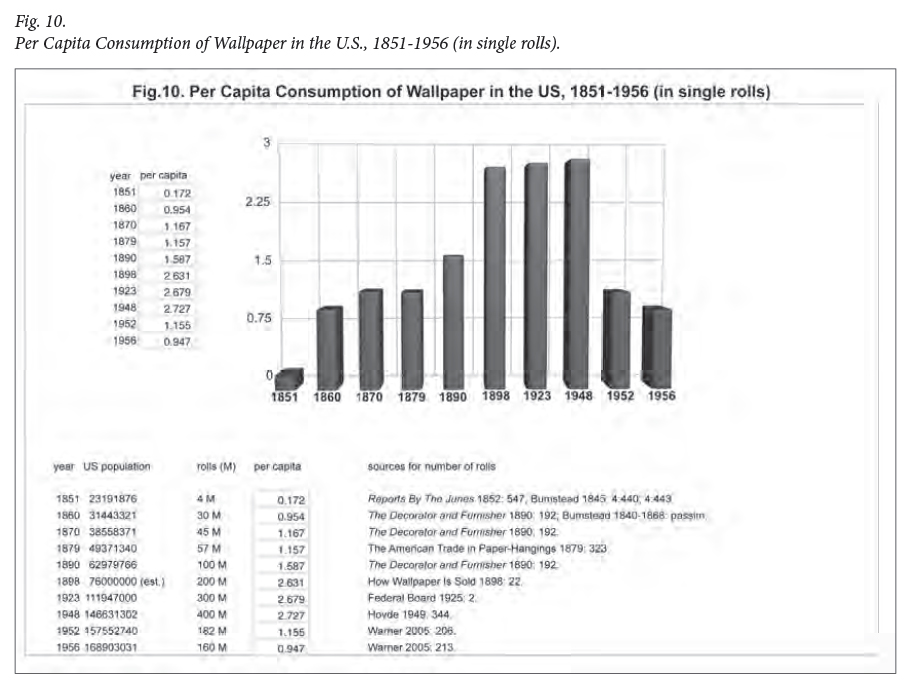 Display large image of Figure 10
Display large image of Figure 1084 To the extent that the consumer is missing from this study, except for the photographic evidence, a full picture of wallpaper use has hardly been presented. Yet, just as the first significant book about English wallpaper was largely an industrial history (A History of English Wallpaper, 1509-1914,bySugden and Edmundson, 1926), so too this first detailed article about Canadian wallpaper could perhaps only have concentrated on the macro picture of production and per capita consumption. In the years after 1926, as the history of English wallpaper became a topic of concern and study, earlier references to wallpaper in correspondence, novels, and newspapers bubbled up. Many of these references and comments were collected in A Literary History of Wallpaper, by Eric Entwisle (1960). This suggests that there may be untapped anecdotal and literary resources for understanding Canadian wallpaper.
85 In the study of wallpaper, pricing has been neglected, and not only in Canada. While a stylistic approach need not consider pricing in great detail, a broader view of wallpaper as a material culture artifact depends greatly on learning how it was valued. How much were people willing to pay for wallpaper? How do those costs relate to other consumer goods? The answers to these questions could lead to a more realistic appraisal of our decorative past. Objects from the past can inform how people organized their daily lives, but domestic decorative objects have a special value: they can inform how people enjoyed their daily lives.
86 As noted, the life of a pattern was rather brief in Canada, as opposed to England, where the same pattern stayed in production for years. Further research might explore the significance of this trait: does it suggest that Canadian society of the late 19th century was less tradition-bound than that of England?
87 For future work in all areas of wallpaper in Canada, the resources uncovered by Leung in 1983 provide a starting point. Her work includes a superlative glossary of technical terms (274-91); references to thirty-six wallpaper- or border-sample books among twenty-one wallpaper collections in Canada; important archives such as the Glenbow Picture Archives in Calgary, Alberta; lists of trade magazines such as Canadian Paint and Varnish Magazine; and lists of company brochures such as “Wallpaper Influence in the Home” (Watson Foster Co. Ltd.).
88 That the Canadian industry could provide its citizens with a low-cost, low-quality product during the 1860-1935 period, against considerable odds, was a unique achievement. Better understanding this contribution to wallpaper heritage may further unlock the importance of historic wallpaper use.
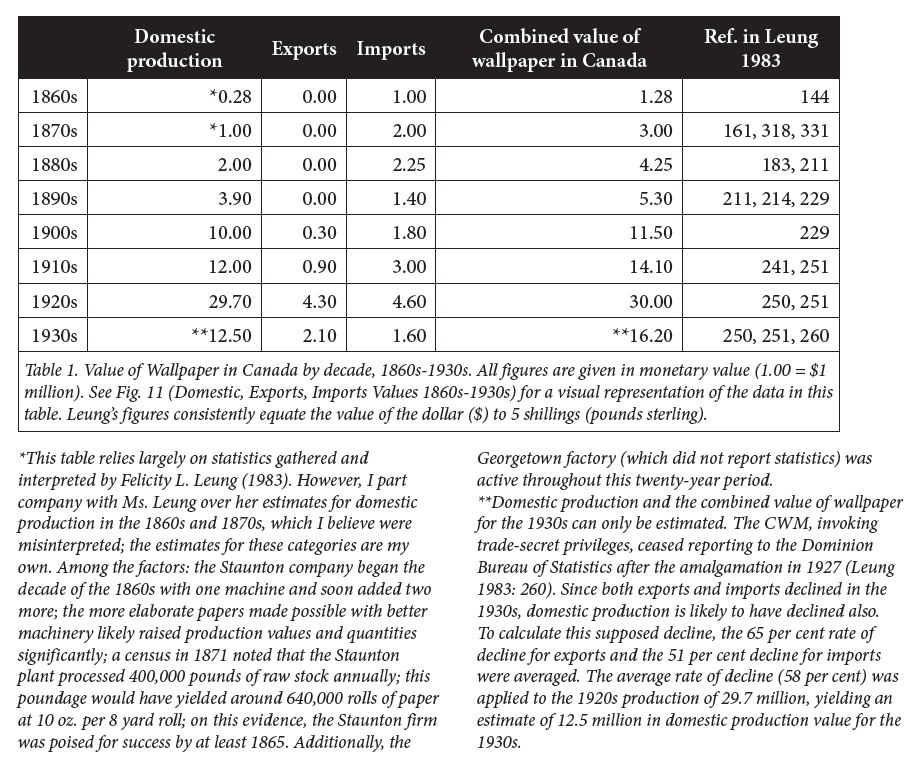 Display large image of Table 1
Display large image of Table 1I wish to thank author David Skinner of Ireland for bringing the Christmas letter, advertisements, and patented designs of Moses Staunton to my attention.
